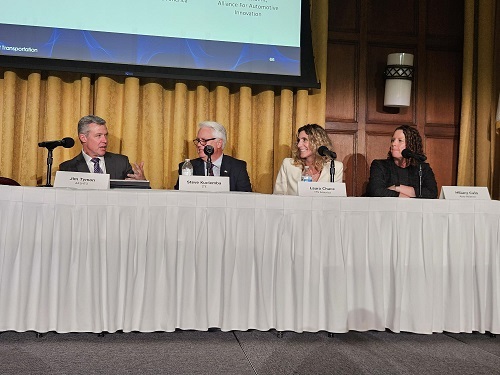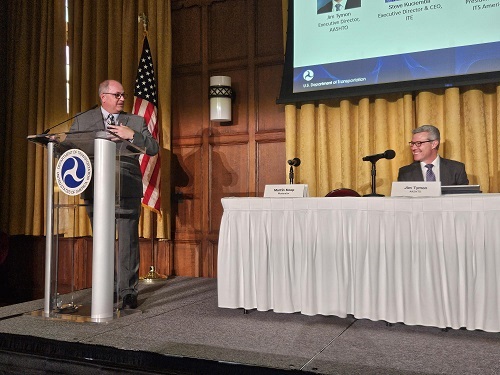Jim Tymon (above), executive director of the American Association of State Highway and Transportation Officials, recently called for the establishment of “consistent principles” as the effort to deploy Vehicle-to-Everything or V2X technology more broadly across the nation heats up.
[Above photo by AASHTO]
Speaking in Michigan at the third in a series of summits held by the U.S. Department of Transportation aimed at eliciting feedback on the recently released draft of its National V2X Deployment Plan, Tymon said the final version of that plan must encourage a “vision” for V2X that is “shared and embraced” by all sectors of the mobility industry – public and private companies, infrastructure owners, automakers, and technology developers, to name just a few – with V2X applications interoperable across all jurisdictions and all makes and models of vehicles.

“One action AASHTO would like to see completed from this summit in the next three months is the ‘socialization’ of the V2X vision to gain stakeholder commitment and public understanding of the benefits this technology brings to vehicular travel – especially its safety benefits,” he said. “Also, interference issues must be addressed by the Federal Communications Commission to allow for the full and reliable use of the remaining 5.9 GHz spectrum.”
Preserving wireless communication spectrum for V2X and other vehicle connectivity needs has been a key focal point for AASHTO and state departments of transportation over the last several years. In fact, AASHTO and the Intelligent Transportation Society of America filed a lawsuit in 2021 in the District of Columbia Circuit Court to prevent the FCC from reallocating swaths of the 5.9 GHz wireless spectrum to non-transportation uses – a lawsuit ultimately dismissed by that court in August 2022.
That lawsuit sought to reverse the November 2020 decision by the FCC to shift 60 percent of the 5.9 GHz spectrum to unlicensed, non-transportation uses, and preserve the full 75-megahertz (MHz) band within the overall 5.9 GHz spectrum for transportation communications. AASHTO and ITS America sought to preserve this “safety spectrum” for transportation systems such as C-V2X.

Meanwhile, AASHTO’s Tymon said that over the next two to three years, the USDOT should exert “strong federal leadership and consistent, sustained, and synergistic policies across all modes for V2X deployment” while encouraging automakers to commit to deploying V2X technologies to mirror their commitment level to building electric vehicles.
“Finally, we must continue efforts by all stakeholders to cement standards that will make V2X usable and interoperable,” he added. “For to see deployment at scale, many, many others will have to be trained so that we have a workforce that can install, operate and maintain the V2X technology.”
To that end, Tymon said AASHTO is “pleased” that USDOT’s draft V2X plan recognizes those workforce needs by incorporating elements of technical assistance and training.
“There is much detail, technical and policy wise, that needs to be worked out for national V2X deployment,” he noted. “That’s why this draft National V2X Deployment Plan is a great start. It is well structured and lays out a clear vision of what is to be accomplished with concrete goals and targets over the short, medium, and long term. This is a great starting point and we look forward to working with USDOT and other stakeholders to refine the plan as needed.”
 Top Stories
Top Stories
Modal Administrators Speak at AASHTO Annual Meeting
December 5, 2025 Top Stories
Top Stories

